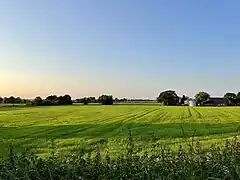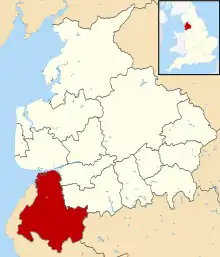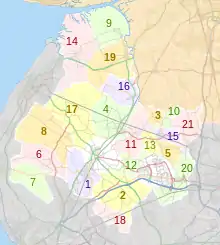West Lancashire | |
|---|---|
 The West Lancashire plain near Burscough | |
 Shown within the ceremonial county of Lancashire | |
| Sovereign state | United Kingdom |
| Constituent country | England |
| Region | North West England |
| Ceremonial county | Lancashire |
| Admin. HQ | Ormskirk |
| Government | |
| • Type | West Lancashire Borough Council |
| • Leadership | Leader and Cabinet |
| • MPs: |
|
| Area | |
| • Total | 133.8 sq mi (346.6 km2) |
| • Rank | 102nd |
| Population (2021) | |
| • Total | 117,125 |
| • Rank | Ranked 204th |
| • Density | 880/sq mi (340/km2) |
| Time zone | UTC+0 (Greenwich Mean Time) |
| • Summer (DST) | UTC+1 (British Summer Time) |
| Postcode | |
| ONS code |
|
| Ethnicity | 98.5% White |
West Lancashire Borough Council | |
|---|---|
 | |
| Type | |
| Type | |
| Leadership | |
| Structure | |
| Seats | 45 |
Political groups | Administration (26)
Other parties (19)
|
| Elections | |
Last election | 4 May 2023 |
Last election | 2024 |
| Meeting place | |
| 52 Derby Street, Ormskirk, L39 2DF | |
| Website | |
| www | |
West Lancashire is a local government district with borough status in Lancashire, England. The council is based in Ormskirk, and the largest town is Skelmersdale. The district borders Fylde to the north, over the Ribble Estuary; South Ribble, Chorley, and Wigan to the east; St Helens, and Knowsley to the south; and Sefton to the south and west.
The borough has a population of 117,400 and an area of 133.8 square miles (347 km2).[4] It is primarily rural, and the most populous settlements after Ormskirk and Skelmersdale are Burscough (9,935), Up Holland (7,578), and Tarleton (5,959).[5] The borough council is based in Ormskirk, and there are twenty-one civil parishes.
The west of the borough contains much of the southern part of the Lancashire Plain, a low-lying region of mossland. A large lake called Martin Mere occupied much of the area until it was drained for agriculture. The northern border of the borough is the Ribble Estuary, and both it and the remnant of Martin Mere are Ramsar sites.[6] In the west the land is rises to Harrock Hill, Parbold Hill, and Ashurst Hill; the River Douglas flows west through the valley between the last two, then turns north and forms the borough boundary.
History
The district was created on 1 April 1974 under the Local Government Act 1972, covering the whole area of two former districts and parts of another two districts, all of which were abolished at the same time:[7]
- Ormskirk Urban District
- Skelmersdale and Holland Urban District
- West Lancashire Rural District (majority of former district's territory; remainder went to Merseyside)
- Wigan Rural District (parishes of Dalton, Parbold and Wrightington; remainder went to Greater Manchester)
In 2009 the district was awarded borough status, causing the council to change its name from West Lancashire District Council to West Lancashire Borough Council, and allowing the chairman of the council to take the title of mayor.[8][9]
Proposals to divide Lancashire into three unitary authorities were put forward in 2020, which would have seen both Lancashire County Council and West Lancashire Borough Council abolished.[10] The Government did not pursue that proposed reform, although left open the possibility of other forms of reorganisation in future.[11]
Governance
West Lancashire Borough Council provides district-level services. County-level services are provided by Lancashire County Council.[12] Parts of the district are also covered by civil parishes, which form a third tier of local government.[13]
The council employs around 600 people, making it one of West Lancashire's largest employers. It is responsible for the administration of various services, such as leisure, waste collection, planning permission and pest control.[2]
Political control
The council has been under Labour majority control since 2023.
The first election to the council was held in 1973, initially operating as a shadow authority alongside the outgoing authorities until the new arrangements came into effect on 1 April 1974. Political control of the council since 1974 has been as follows:[14][15]
| Party in control | Years | |
|---|---|---|
| No overall control | 1974–1976 | |
| Conservative | 1976–1986 | |
| No overall control | 1986–1987 | |
| Conservative | 1987–1991 | |
| No overall control | 1991–1994 | |
| Labour | 1994–2002 | |
| Conservative | 2002–2014 | |
| No overall control | 2014–2015 | |
| Labour | 2015–2021 | |
| No overall control | 2021–2023 | |
| Labour | 2023–present | |
Leadership
The role of mayor is largely ceremonial in West Lancashire. Political leadership is instead provided by the leader of the council. The leaders since 1992 have been:[16]
| Councillor | Party | From | To | |
|---|---|---|---|---|
| Alan Bullen | Labour | 1992 | 15 May 2002 | |
| Geoff Roberts | Conservative | 15 May 2002 | 21 May 2008 | |
| Ian Grant | Conservative | 21 May 2008 | 25 May 2014 | |
| David Westley | Conservative | 11 Jun 2014 | 20 May 2015 | |
| Ian Moran | Labour | 20 May 2015 | 8 May 2022 | |
| Yvonne Gagen | Labour | 18 May 2022 | ||
Composition
Following the 2023 election, the composition of the council was:[17]
| Party | Councillors | |
|---|---|---|
| Labour | 26 | |
| Conservative | 15 | |
| OWL | 4 | |
| Total | 45 | |
The next election is due in 2024.
Premises
The council is based at 52 Derby Street in Ormskirk, which was originally a pair of large semi-detached Victorian houses called Beaconsfield (number 52) and Abbotsford (number 54).[18] Beaconsfield was purchased in 1925 by West Lancashire Rural District Council, one of the modern council's predecessors, and converted to become its headquarters, being formally opened on 30 July 1925.[19] Abbotsford was acquired later and the building has been significantly extended to the rear.[20]
Elections
Since the last boundary changes in 2023 the council has comprised 45 councillors representing 15 wards, with each ward electing three councillors. Elections are held three years out of every four, with a third of the council (one councillor for each ward) being elected each time for a four-year term. Lancashire County Council elections are held in the fourth year of the cycle when there are no borough council elections.[21]
Wards and councillors
Since the last election in May 2023, the composition of the council has been as follows. The next election is due in 2024.[22]
| Ward | Name | Party | |
|---|---|---|---|
| Aughton and Holborn | Paul Hennessy | Labour Party | |
| Sarah Lawton | Labour Party | ||
| Kerry Lloyd | Labour Party | ||
| Burscough Bridge and Rufford | John Gordon | Conservative Party | |
| Eddie Pope | Conservative Party | ||
| Jayne Rear | Conservative Party | ||
| Burscough Town | Patricia Burnside | Labour Party | |
| Andrew Fowler | Labour Party | ||
| Paul Hesketh | Our West Lancashire | ||
| North Meols and Hesketh Bank | Ian Eccles | Conservative Party | |
| Thomas De Freitas | Conservative Party | ||
| John Howard | Conservative Party | ||
| Old Skelmersdale | Neil Furey | Labour Party | |
| Nicola Pryce-Roberts | Labour Party | ||
| Donna West | Labour Party | ||
| Ormskirk East | Nicola Hennessy | Labour Party | |
| Robert Molloy | Labour Party | ||
| Adam Yates | Labour Party | ||
| Ormskirk West | Mark Anderson | Labour Party | |
| Gareth Dowling | Labour Party | ||
| Anne Fennell | Labour Party | ||
| Rural North East | Robert Bailey | Conservative Party | |
| Katie Juckes | Conservative Party | ||
| David Whittington | Conservative Party | ||
| Rural South | Thomas Marsh-Pritchard | Our West Lancashire | |
| Ian Rigby | Our West Lancashire | ||
| Linda Webster | Our West Lancashire | ||
| Rural West | Alexander Blundell | Conservative Party | |
| Jane Marshall | Conservative Party | ||
| Marilyn Westley | Conservative Party | ||
| Skelmersdale North | Terence Devine | Labour Party | |
| Yvonne Gagen | Labour Party | ||
| Melissa Parlour | Labour Party | ||
| Skelmersdale South | Terence Aldridge | Labour Party | |
| Victoria Cummins | Labour Party | ||
| Julian Finch | Labour Party | ||
| Tanhouse and Skelmersdale Town Centre | Carl Coughlan | Labour Party | |
| Paul Hogan | Labour Party | ||
| Maureen Nixon | Labour Party | ||
| Tarleton Village | Darren Daniels | Conservative Party | |
| David Westley | Conservative Party | ||
| Joan Witter | Conservative Party | ||
| Up Holland | John Fillis | Labour Party | |
| Gaynar Owen | Labour Party | ||
| Suresh Patel | Labour Party | ||
Parliamentary constituencies
The south of West Lancashire, including the towns of Burscough, Skelmersdale and Ormskirk fall under the West Lancashire constituency in the House of Commons, which has been represented by Labour Party MP Ashley Dalton since the 2023 West Lancashire by-election, whereas the north of West Lancashire falls under the South Ribble constituency, which has been represented by Conservative Party MP Katherine Fletcher since the 2019 general election.
Geography

Skelmersdale, a former New Town, and Ormskirk are the two main towns in the borough. These are surrounded by a patchwork of smaller settlements to the west and north.
Civil parishes

There are 21 civil parishes in West Lancashire. The main towns of Skelmersdale and Ormskirk are unparished areas. There is a movement to establish a town council in Skelmersdale.[23] The parish council of Burscough takes the style "town council".[24]
All the civil parishes have a parish council, with the exception of Bispham, which has a parish meeting instead.
Twin towns
West Lancashire is twinned with:[25]
|
|
References
- ↑ "Council minutes, 18 May 2022" (PDF). West Lancashire Borough Council. Retrieved 26 August 2022.
- 1 2 "Management of the Council". West Lancashire Borough Council. Retrieved 13 December 2020.
- ↑ "Jacqui Sinnott-Lacey appointed as West Lancashire Borough Council's new Chief Operating Officer". Skem News. 7 January 2020. Retrieved 27 June 2023.
- ↑ "How life has changed in West Lancashire: Census 2021". Office for National Statistics. Retrieved 18 December 2023.
- ↑ Parish populations.
- ↑ "NCA Profile: 32 Lancashire and Amounderness Plain - NE512". Natural England. Retrieved 18 December 2023.
- ↑ "The English Non-metropolitan Districts (Definition) Order 1972", legislation.gov.uk, The National Archives, SI 1972/2039, retrieved 22 August 2022
- ↑ "Orders and changes made by the Government and Councils between 1 April 2008 and 31 March 2009" (PDF). Ministry for Housing, Communities and Local Government. Retrieved 4 July 2022.
- ↑ "The Royal Charter". West Lancashire District Council. 13 May 2009. Archived from the original on 6 June 2011. Retrieved 28 May 2009.
- ↑ "Lancashire councils face abolition in shake-up". BBC. Retrieved 22 September 2020.
- ↑ Faulkner, Paul (28 July 2021). "Where plans to carve up Lancashire and abolish its 15 councils are up to". Lancs Live. Retrieved 26 August 2022.
- ↑ "Local Government Act 1972", legislation.gov.uk, The National Archives, 1972 c. 70, retrieved 31 May 2023
- ↑ "Election maps". Ordnance Survey. Retrieved 6 June 2023.
- ↑ "Compositions calculator". The Elections Centre. 4 March 2016. Retrieved 1 June 2023.
- ↑ "West Lancashire". BBC News Online. 19 April 2008. Retrieved 13 April 2010.
- ↑ "Council minutes". West Lancashire Borough Council. Retrieved 26 August 2022.
- ↑ "Local elections 2023: live council results for England". The Guardian.
- ↑ 1911 Census, Class RG14; Piece 22822; Schedules 220–221
- ↑ "West Lancashire Council's new offices". Ormskirk Advertiser. 6 August 1925. p. 3. Retrieved 27 August 2022.
- ↑ "West Lancashire Borough Council". Retrieved 27 August 2022.
- ↑ "The West Lancashire (Electoral Changes) Order 2022", legislation.gov.uk, The National Archives, SI 2022/1179, retrieved 27 June 2023
- ↑ "Your Councillors". West Lancashire Borough Council. Retrieved 27 August 2022.
- ↑ "Skelmersdale Independent Party". Skelmersdale Independent Party. Retrieved 22 September 2020.
- ↑ "Parish councils contact information". West Lancashire Borough Council. Retrieved 28 June 2023.
- ↑ West Lancashire Borough Council, Town Twinning retrieved 21 January 2019
